This first table shows the HWLabs Nemesis 140 GTX’s Watts/10 Delta Temp results with our flow rate of 1.0 GPM.
 Using this data we can effectively show percentage gains/losses relative to a reference point. It’s an interesting way to show gains/losses while changing a variable.
Using this data we can effectively show percentage gains/losses relative to a reference point. It’s an interesting way to show gains/losses while changing a variable.
So, let’s focus on 1300 RPM as our reference and see how much gain or loss in performance we get by changing fan speed.

The significant drop form 1300 rpm to 750 rpm in Push Only hints a possible performance weak point of the Nemesis 140 GTX. We saw similar performance drop off in Push Only of 45.5% on the Nemesis 360 GTX
So from the data above we have a good idea of how the Nemesis 140 GTX radiator performs relative to itself. But there is a large selection of 140mm radiator models to choose from.
We have some other 140mm radiators with thermal testing completed. So let’s put the Nemesis 140 GTX’s results into some comparison charts.
Push Only Data vs Competition
Let’s focus on the Push Only results for now and come back to the Push/Pull data later.
Starting with 750 RPM let’s see how the Nemesis 140 GTX performs comparatively.
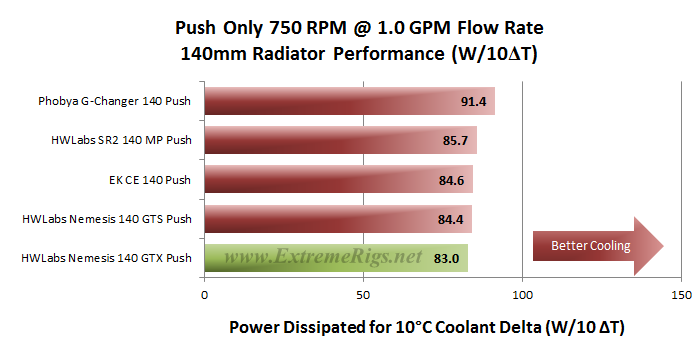
Results are always close at this data point, but here we see a clear winner. As our performance table indicated this is a weak result for the Nemesis 140 GTX. Of special interest is the Nemesis 140 GTS out performing it’s thicker sibling. Finishing ~9% behind the wining rad we hope things improve from here.
When testing the Nemesis 360 GTX we found that with low fan speeds in Push Only, a reversed coolant flow path produced better thermal results than Opti-Flow. This is surprising and not expected, but was consistent with every Nemesis we tested and re-tested. While we don’t have data to prove it, we see no reason why it would be any different for the Nemesis 140 GTX.
Now let’s look at 1300 rpm:
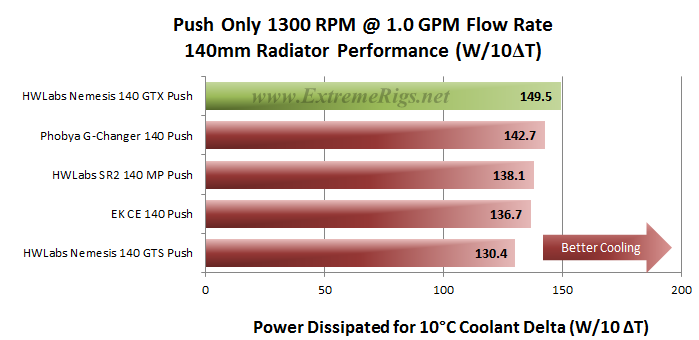
At 1300 rpm Push Only the Nemesis 140 GTX shoots out to take 1st place. There is something about the Nemesis GTX rads where they perform poorly at low rpm at Push Only.
At 1850 rpm the Nemesis 140 GTX again takes 1st place and is pulling further ahead of the competition.
The Push Only comparison results for the Nemesis 140 GTX are mixed, ranging from worst with low fan speed to best in both the medium and high speed fan tests. When adding the second fan for Push/Pull we expect the dominance with higher air flow to continue.
Push/Pull Data vs. Competition
Let’s now look at the Push/Pull results and see how the Nemesis 140 GTX compares.
Again the 750 rpm first:
The Nemesis 140 GTX 140 turns out another first place performance, ~3.5% ahead of second place.
Let’s move to 1300 rpm:
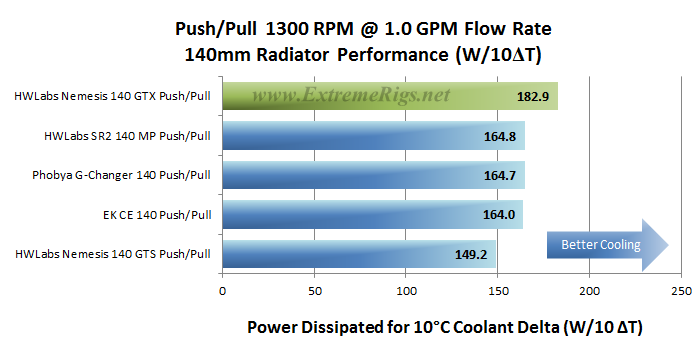 The 1300 rpm Push/Pull result for the Nemesis 140 GTX was excellent! Taking another win, this time ~11% ahead of the competition.
The 1300 rpm Push/Pull result for the Nemesis 140 GTX was excellent! Taking another win, this time ~11% ahead of the competition.
Now 1850RPM:
At 1850 rpm Push/Pull the Nemesis 140 GTX again finishes first.
Let’s now combine the Push Only and Push/Pull results of our 1.0 GPM flow rate tests. Sometimes these combined plots show up some points of interest.
Again the 750 rpm first:
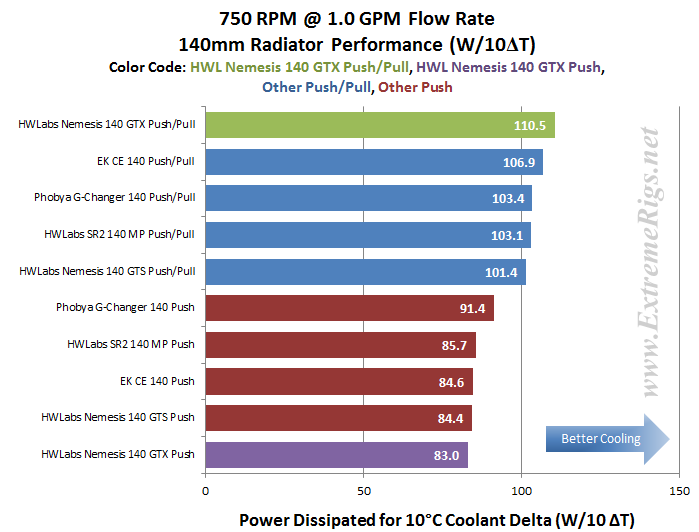 I am pretty sure we haven’t seen this before, the same radiator finishing first and last on the same plot.
I am pretty sure we haven’t seen this before, the same radiator finishing first and last on the same plot.
However, at 1300 rpm the Nemesis 140 GTX’s Push Only result improves dramatically to beat out the GTS in Push/Pull.
At 1850, there are no surprises given what we have already reviewed.
Quite an outstanding set of comparison results for the Nemesis 140 GTX, taking 5 wins out of the 6 data points at which we conducted the thermal testing.
Here is one last alternate view of the data before we move onto the summary. This time the data is plotted as extrapolated curves.
Push Only first up: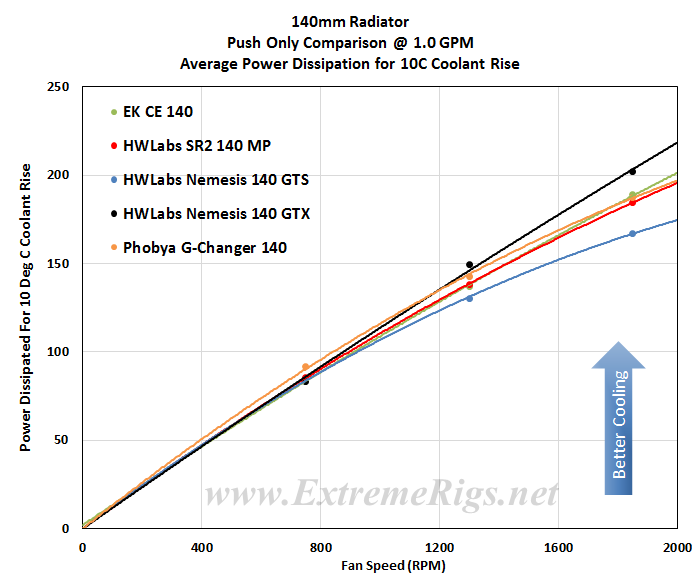 This plot perhaps best shows just how close the Push Only results are at the low fan speeds while at the high fan speed we clearly see the performance advantage the Nemesis 140 GTX has over the competition.
This plot perhaps best shows just how close the Push Only results are at the low fan speeds while at the high fan speed we clearly see the performance advantage the Nemesis 140 GTX has over the competition.
In the Push/Pull setup we see a bit more separation occurring. As the fan speeds are increased the different core designs show their strengths and weaknesses.
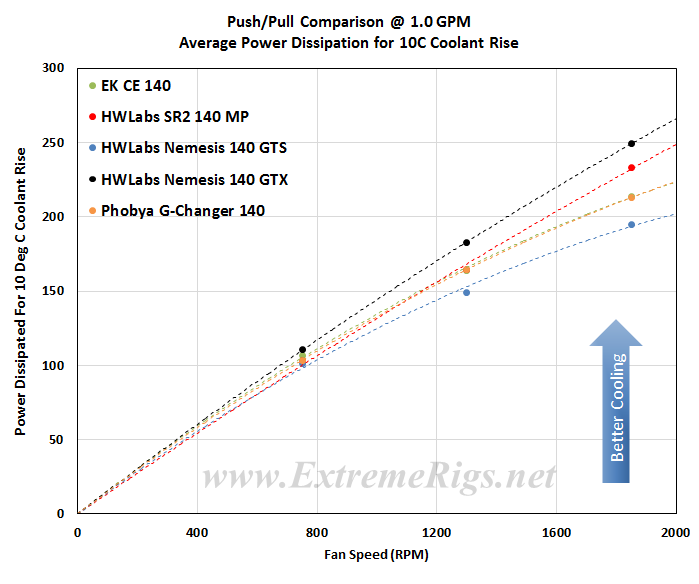 At 1850 RPM Push/Pull the Nemesis 140 GTX wins at all three fan speeds. It’s comparison performance continues to improve as the fan speed is increased.
At 1850 RPM Push/Pull the Nemesis 140 GTX wins at all three fan speeds. It’s comparison performance continues to improve as the fan speed is increased.
From all the test results we created “Average Performance Factor” charts for both Push and Push/Pull. We then made a combined plot of the average called the “Master Performance Factor”. The radiator with the best cooling ability (W/10ΔT) at each rpm was awarded a score of 100. Each other radiators W/10ΔT result was scored as percentage of the top performer.
This way of looking at the comparison takes away any advantages that a radiator may have at higher or lower fan speeds and looks at an overall average. While this appears fair it does tend to favor those radiators that are all-rounders and those radiators which do very well at high RPM. Most users should be more focused on their specific use case.
Here are the Nemesis 140 GTX’s percentage scores at each data point:
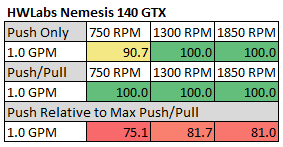 Clearly we see the Nemesis 140 GTX was dominant in 5 of the 6 data points tested. Additionally it also highlights the weak performance point it has. This should make for some excellent APF scores but will it’s one low results prevent it from taking the trifecta of APF wins?
Clearly we see the Nemesis 140 GTX was dominant in 5 of the 6 data points tested. Additionally it also highlights the weak performance point it has. This should make for some excellent APF scores but will it’s one low results prevent it from taking the trifecta of APF wins?
The percentage numbers in the table above offer another way of looking at the Nemesis 140 GTX’s results. But for our scoring system we need a way to reduce the categories while retaining the data. To do this we average the results for each fan assembly type giving us Averaged Performance Factors. We calculate this for Push Only, Push/Pull and finally an average of everything.
Firstly – the Push Only APF:
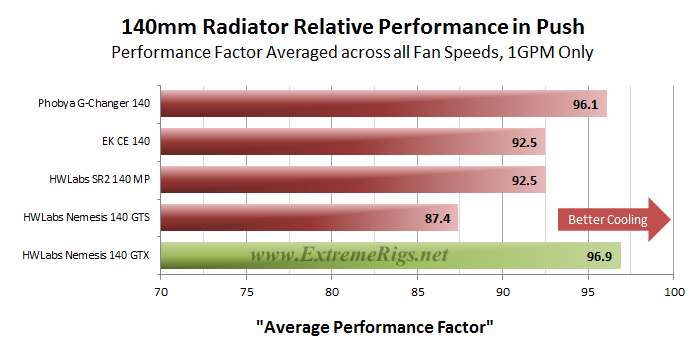
The Nemesis 140 GTX’s excellent Push Only APF score of 96.9 was good enough to take 1st place.
Now the Push/Pull APF:
Having placed 1st in each of the 3 Push/Pull tests, the Nemesis 140 GTX was the clearly the dominant radiator in this category.
Finally we created the Master Performance Factor which is calculated from the averaged results of all the tests: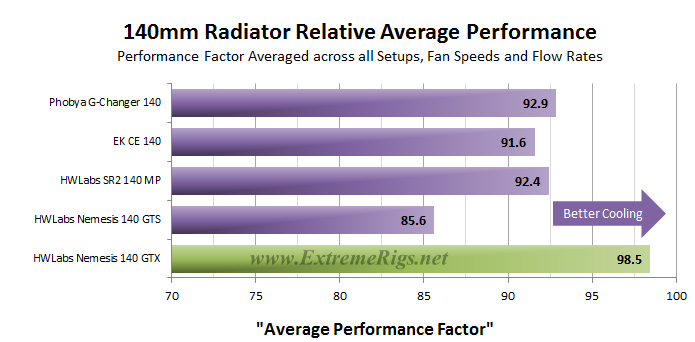 Overall the Nemesis 140 GTX placed 1st in our thermal test comparisons. With 5 out of 6 category wins, it’s performance was indeed truly excellent in all but the low speed Push Only test.
Overall the Nemesis 140 GTX placed 1st in our thermal test comparisons. With 5 out of 6 category wins, it’s performance was indeed truly excellent in all but the low speed Push Only test.
Next up – Summary!







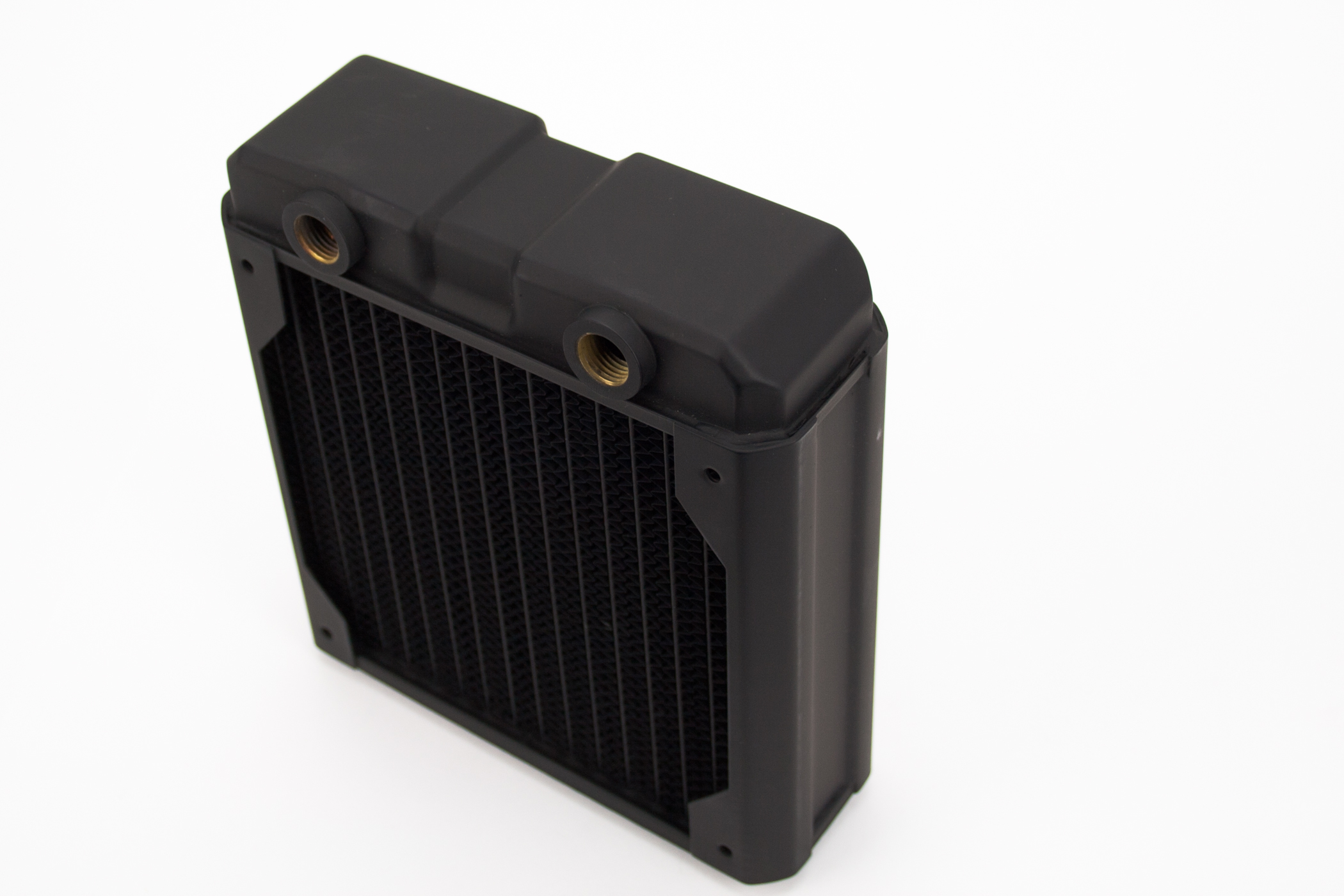
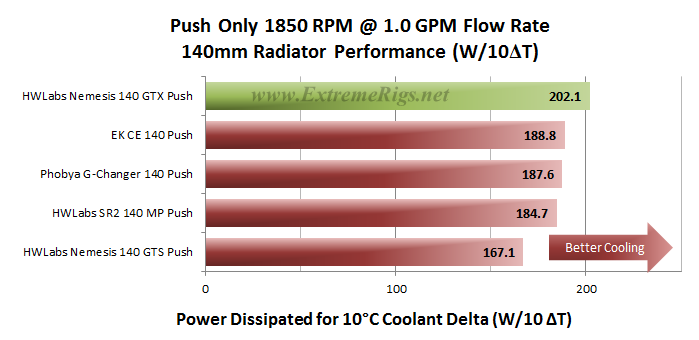
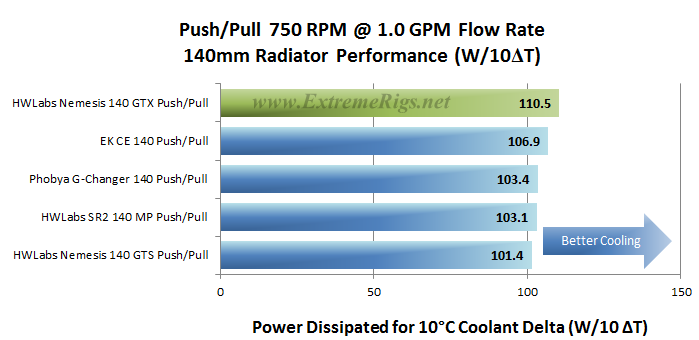
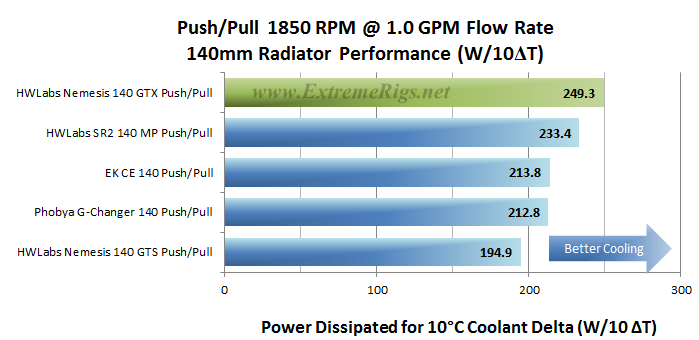
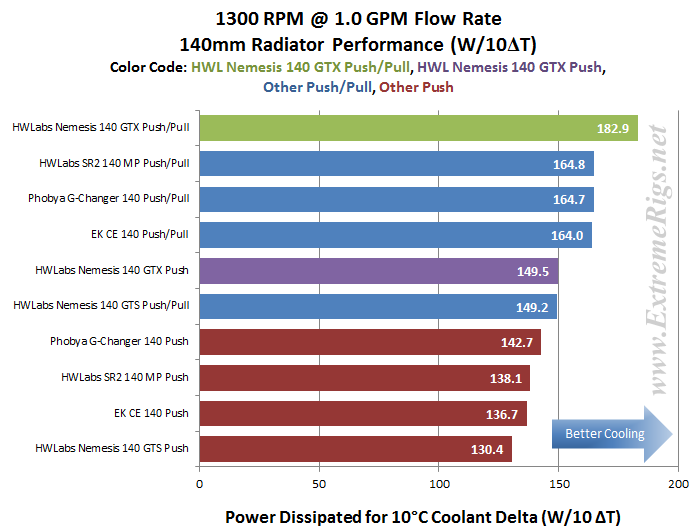
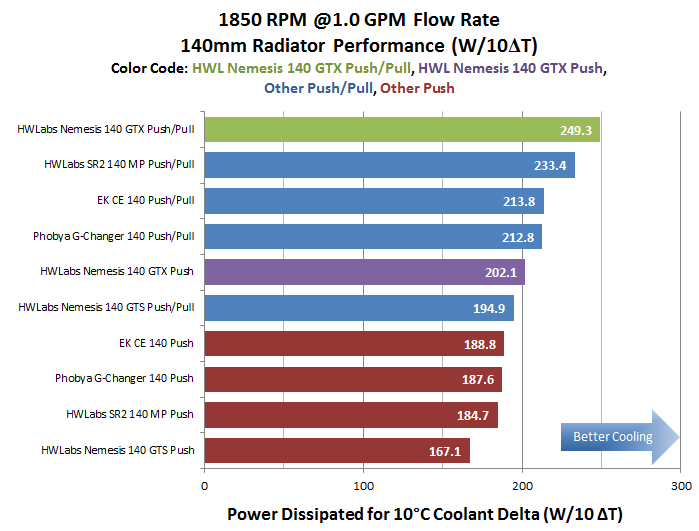
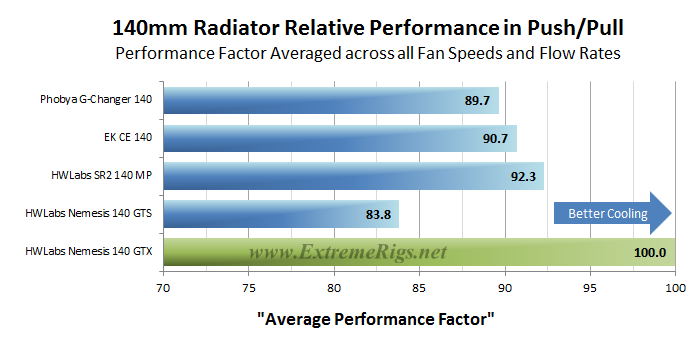



I really wish the 500rpm fan speed was tested with radiators on this site for lower noise builds. I’m trying to decide between a HWlabs GTX 140 and EK CE 140, and this extra data could push me off the fence either way.
In curious as to whether the GTXs performance would fall behind the CE in push pull at these fan speeds, since in the single fan configuration is is at the bottom of the 750rpm range.
The extrapolated plot makes it seems like the GTX would still beat the CE in push/pull: https://www.xtremerigs.net/wp-content/uploads/2015/11/140-W10DTPPvs.png
Sadly we can’t test every data point, to get this quality of data takes about a month per radiator so adding more data points just kills us!
Comments are closed.